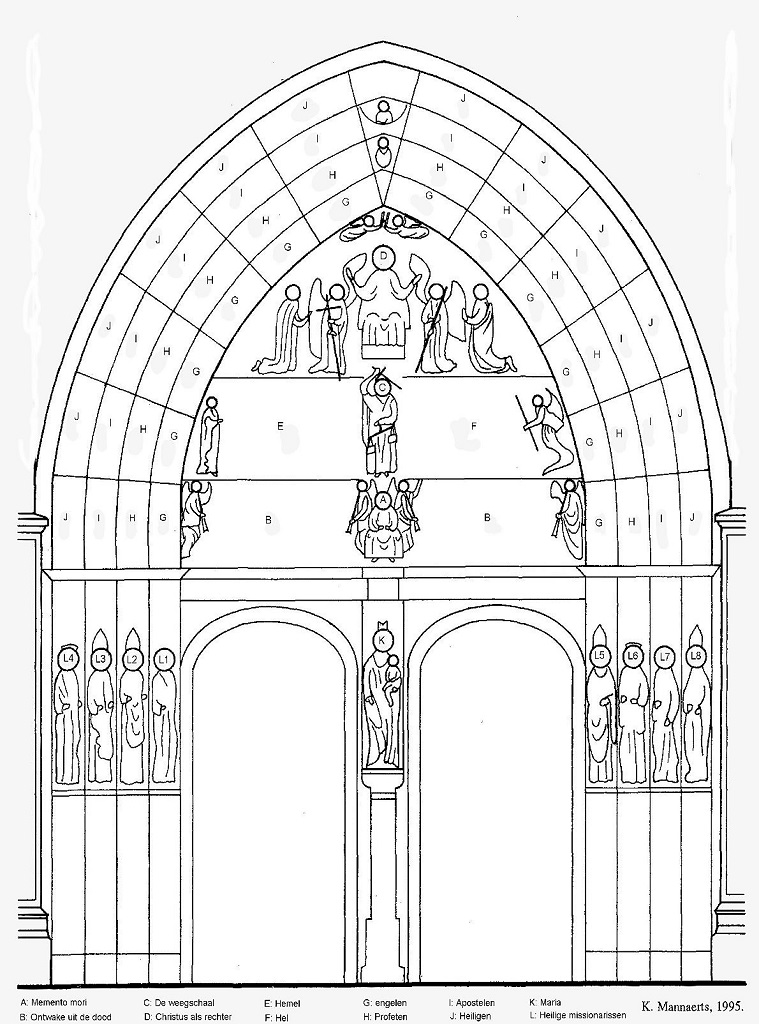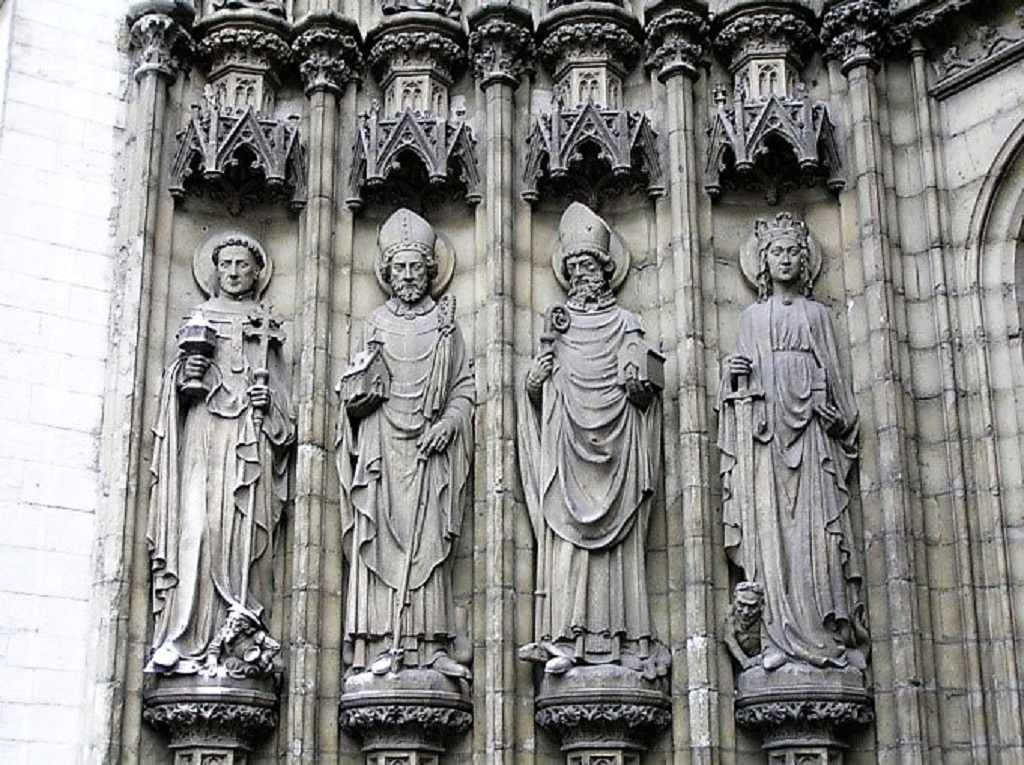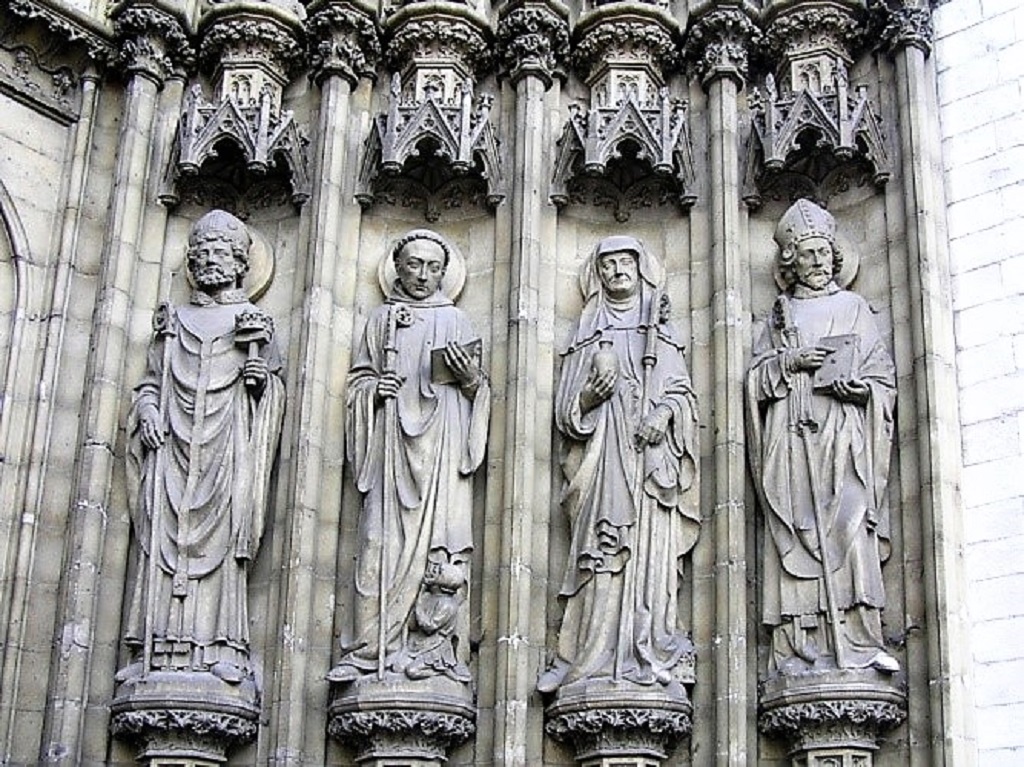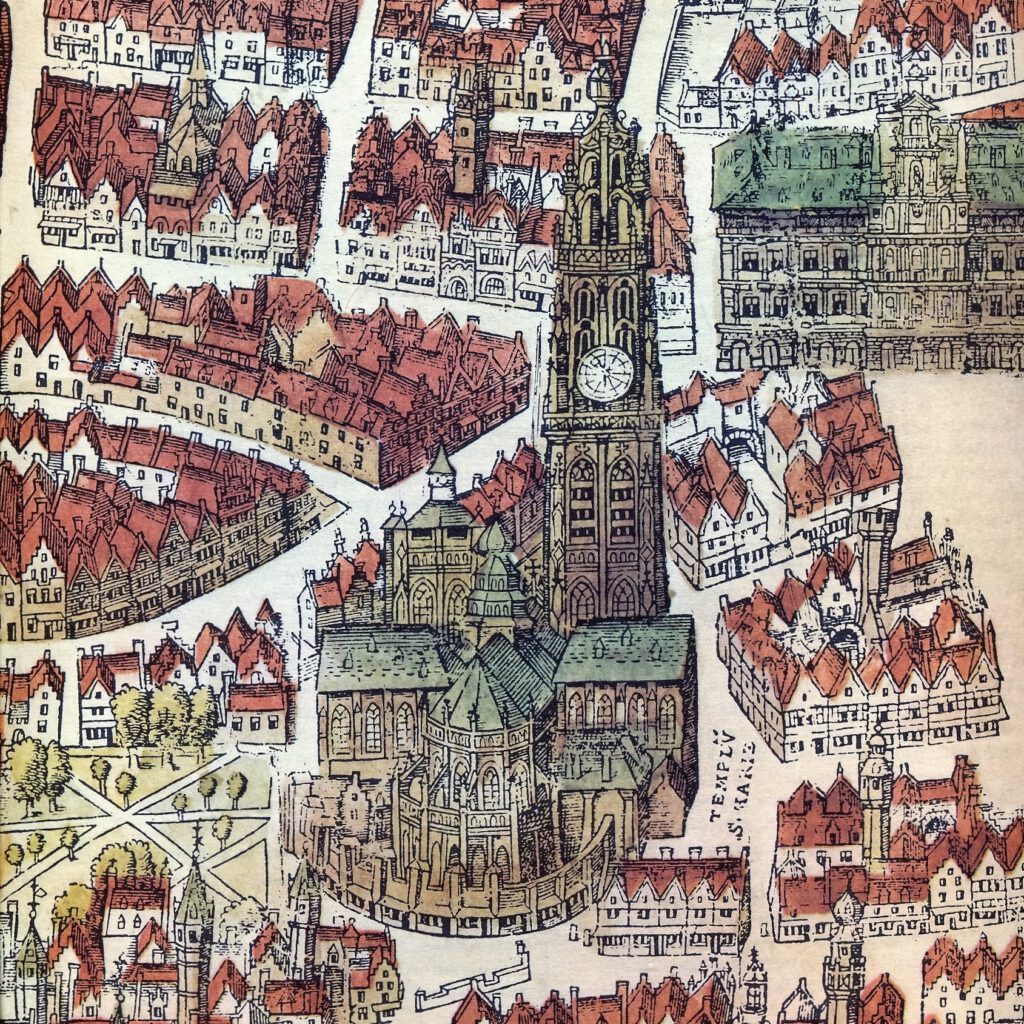The Our Lady’s Cathedral of Antwerp, a revelation.
The façade with the main portal:
The Last Judgment
The cathedralThe main church of a diocese, where the bishop’s seat is. definitely lacks a majestic entrance. From the beginning, at the start of the above ground works at the Northern tower in 1422, there was no longer need for steps. To adapt to the consequences of spring tides threatening the city since the Scheldt – the present Western Scheldt – had found its new bed not only the church floor, but even more the surrounding streets and squares were levelled up.
The main portal is oriented towards the West, which, with the setting sun, carries in it the primal symbolism of decay and death. The church behind the door is ‘the house of God’ and so symbolizes Heaven. Those who enter Heavenly Jerusalem here get a serious warning above their heads, as in so many medieval churches, the Last Judgement on the tympanum. This tableau was painted in bright colours in various successive versions until the 18th century. The neo-Gothic main portal, by Jean-Baptist van Wint, only dates back to 1903!

The motif of memento mori or the thought of death emphasizes this warning. A monkA male member of a monastic order who concentrates on a life of balance between prayer and work in the seclusion of a monastery or abbey. keeps his mind on the approaching future: in his lap there is a skull. In the lowest section people wake up from death, just as if they awoke on an lazy morning. At the four corners of the Earth (Apoc. 7:1) angels give a signal by blowing the trumpet (Apoc. 8:2.6). Knights, common people and a monk represent nobility, citizenry and clergy. All medieval classes are present because for death everybody is equal. In the second section every human ends up on a pair of scales, held by archangel Michael. The human soul, the deepest kernel of his personality – represented by a small human figure – is carefully weighed. In other words, the final report states whether good or bad was decisive in your life. The actual judge of the final verdict is Christ, who sits on top on his bench. His power over evil and death is beyond any doubt. At both sides of his throne his signs of victory are exhibited: the cross on which he was tortured to death and the spear that pierced his heart. Mary and John the Baptist act as advocates to receive mercy for some poor wretched ones. The division between the good and the bad ones in this judgment is done according to the symbolism of left and right, which Jesus himself used in the passage about the works of mercy (Mth. 25:33-31.41). When good is predominant the scale tips towards Heaven. The blessedUsed of a person who has been beatified. Beatification precedes canonisation and means likewise that the Church recognises that this deceased person has lived a particularly righteous and faithful life. Like a saint, he/she may be venerated (not worshipped). Some beatified people are never canonised, usually because they have only a local significance. ones are rewarded with nice clothes and a crown, and smile, anticipating being welcomed by Saint PeterHe was one of the twelve apostles. He was a fisherman who, together with his brother Andrew, was called by Jesus to follow Him. He is the disciple most often mentioned In the Gospels and the Acts of the Apostles. His original name was Simon. He got his nickname Peter (i.e. rock) from Jesus, who, according to tradition, said that He would build His Church on this rock., who with his keys opens Heaven’s door for them. At Jesus’s left hand side those for whom evil dominated are driven to hell to be punished there. Naked they fall victim to blazing flames and cry out with pain. Devilish figures pull at them with hooked instruments and push the damned ones forward towards the mouth of the monster of darkness, the entrance to hell.
In the archivolts a heavenly court is positioned in a fan-shaped formation, in order of merit, around Christ to do Him honour. In the front rank angels are singing and making music, because Heaven is full of joy. Among the instruments we perceive a violin and a portative organ. In the second arch there are Old TestamentPart of the Bible with texts from before the birth of Jesus. figures, including a great number of prophets reading out quotations in Latin from their own texts. Then in the third rank the twelve apostles can be recognized by their attributes. In the external rank there are all kinds of saints, including the Western and Eastern church fathers. In the centre of the portal you are welcomed by Mary, to whom the church has been devoted. She shows her son, Jesus, the Saviour of the world.
Below, in the portal walls also saints welcome us in Heavenly Jerusalem. These so-called Antwerp saints were not Antwerpians themselves, but resided here for a while, most of them in times of Christianization. Missionary bishops of the first hour (7th century) are: Eligius from France, Amandus from Aquitaine and Willibrord from England. Without them there would never have been a cathedral here. Two women went further inland passing by Antwerp: Walburga and the Irish princess Dymphna (6th century), who was on the run for her pagan fatherPriest who is a member of a religious order., who wanted to commit incest with her. In Geel (province of Antwerp) she was decapitated by him in a fit of devilish insanity. This is why in Geel she is venerated against mental diseases. SaintThis is a title that the Church bestows on a deceased person who has lived a particularly righteous and faithful life. In the Roman Catholic and Orthodox Church, saints may be venerated (not worshipped). Several saints are also martyrs. Norbert (beginning 12th century), who crushed Tanchelm’s heresy, was also at the cradle of this church.






